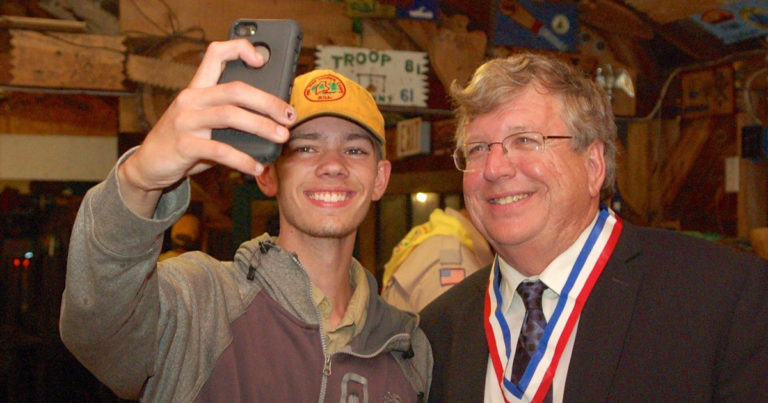Why you should thank this Eagle Scout every time you take a selfie

The latest iPhones and Androids are millimeters thick but contain cameras capable of capturing magazine-quality photos.
It wouldn’t be possible without Eagle Scout Eric Fossum.
In 1992, Fossum developed the little sensor that allowed cameras to be smaller, cheaper and gentler on battery life. Technically, it’s called the complementary metal oxide semiconductor image sensor, but most people just call it the CMOS image sensor.
Well, most people don’t even know that Fossum’s sensor is there. They just know their smartphone, webcam or other small device with a camera takes photos better than the ones giant cameras could take decades ago.
Fossum developed the CMOS sensor while working at the NASA Jet Propulsion Laboratory in California.
“We were trying to improve the performance of cameras in space as well as make them more resistance [sic] to radiation,” he told Time magazine.
Fossum figured the sensor would have applications beyond deep space, but he told Time that he has been surprised by all of the modern uses for the sensor — “from selfies taken by smartphones to pill cameras that can look inside your small intestine.”
Earlier this year, Fossum was awarded the Queen Elizabeth Prize, a British award that honors groundbreaking innovations in engineering. He told Time that he hopes his story and his award will encourage young people, like Scouts, to pursue education and careers in STEM fields like engineering.
“In school, children are often taught to get the right answer, but in engineering and invention you don’t often get the right answer at the right time,” Fossum told Time. “It took us several years to get CMOS right, and that was just in the research lab. … You have to repeat and try again. It’s really important for students and teachers to learn and understand that lesson.”

It started in Scouting
At age 14, Fossum received Scouting’s highest honor. He became an Eagle Scout on May 9, 1973, as a member of Troop 94 of Simsbury, Conn., part of the Connecticut Rivers Council.
After high school, Fossum got a bachelor’s degree in physics and engineering from Trinity College in Hartford, Conn. He followed that with a doctorate in engineering from Yale University.
Fossum taught at Columbia University in the electrical engineering department from 1984 to 1990. He then joined the Jet Propulsion Laboratory, leading the image sensor department.
Fossum invented the CMOS active pixel sensor camera-on-a-chip technology while at NASA and led its transfer of the technology to U.S. industry.
He co-founded Photobit Corp. in 1995 to commercialize the technology. In late 2001, Micron Technology Inc. acquired Photobit. After that, Fossum held a number of roles with various technology companies before joining Dartmouth in 2010.
These days, he’s a professor at the Thayer School of Engineering at Dartmouth in Hanover, N.H., where he teaches, performs research on the Quanta Image Sensor, and directs the school’s Ph.D. Innovation Program.
Did I mention he holds 160 U.S. patents and was inducted into the National Inventors Hall of Fame?
So, yeah. He’s an engineering rockstar.

Distinguished Eagle Scout
Fossum became a Distinguished Eagle Scout on Aug. 18, 2017.
The Distinguished Eagle Scout Award recognizes Eagle Scouts who earned Eagle at least 25 years ago and have received national-level recognition or fame within their field.
The Maine-based Pine Tree Council presented the award.
Jack O’Toole, an Eagle Scout and Pine Tree Council board member, send me the news of Fossum’s latest award.
“Eric Fossum has been an amazingly successful scientist and a great person,” O’Toole said. “I think that he would be an inspiring example to Scouts.”




Why you should thank this Eagle Scout every time you take a selfie
